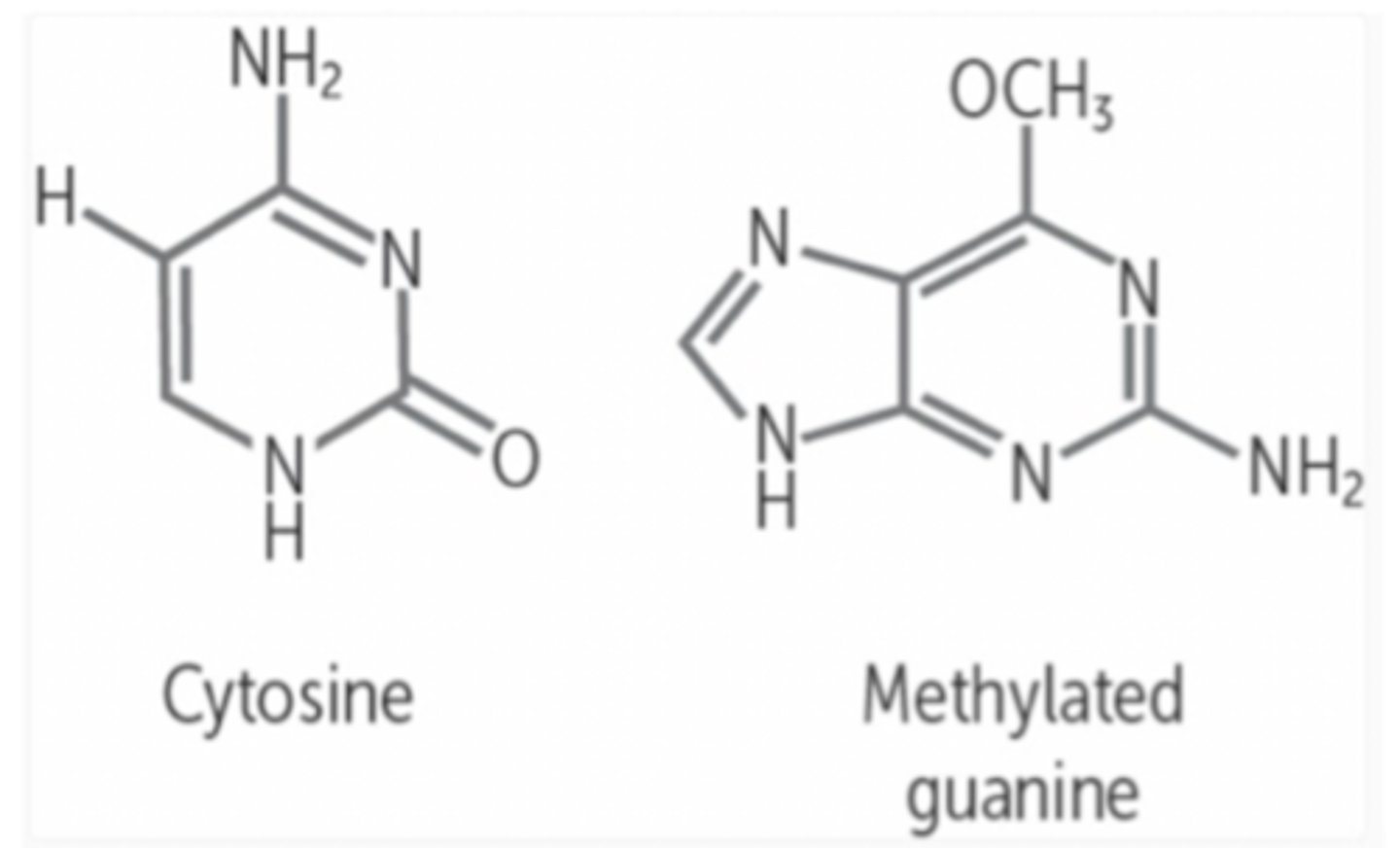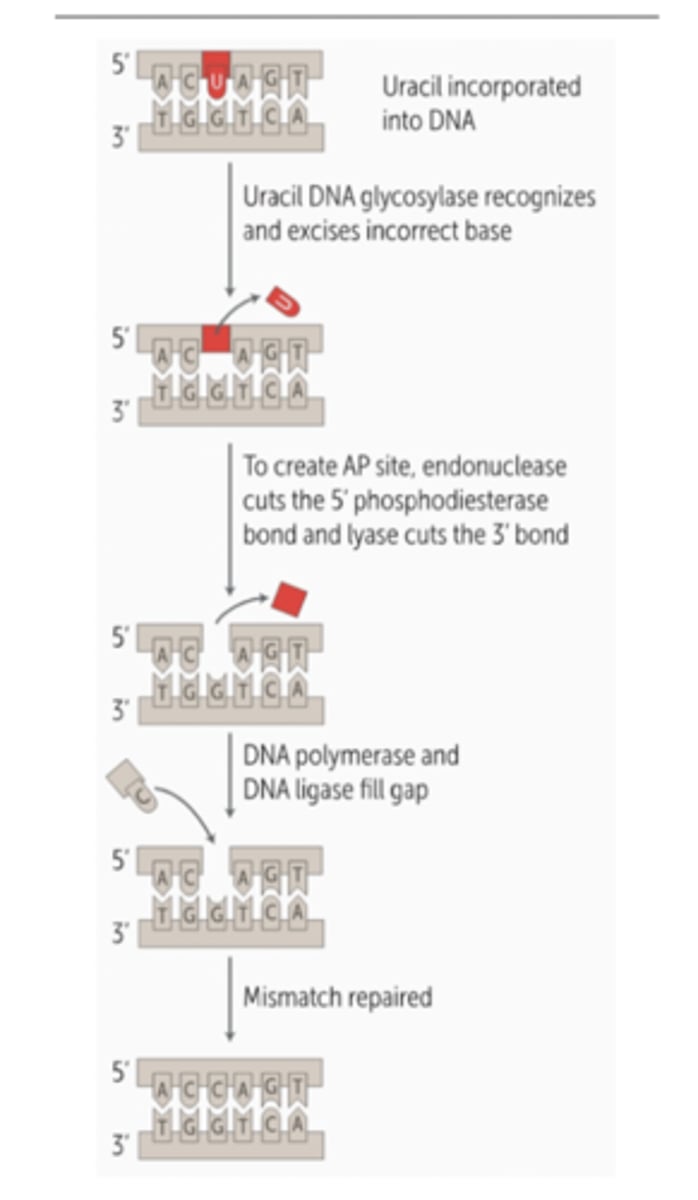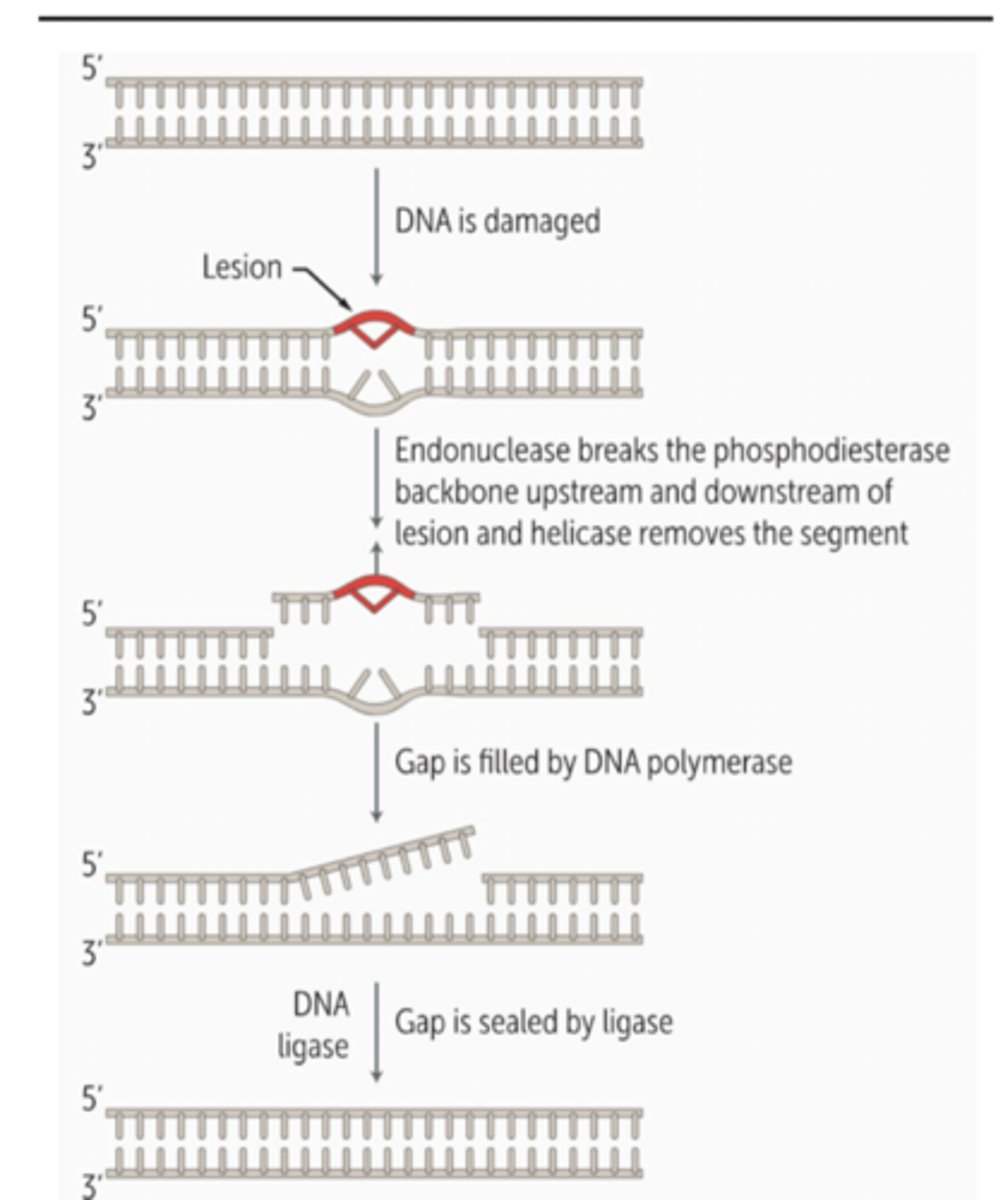DNA Repair
1/25
There's no tags or description
Looks like no tags are added yet.
Name | Mastery | Learn | Test | Matching | Spaced |
|---|
No study sessions yet.
26 Terms
What are mutations? What effects do they have on cells?
Mutations refer to when a DNA lesion is not corrected and causes a change in the DNA base sequence - cells halt division if a high level of damage is detected and attempt DNA repair, but if too much damage, special mechanisms for apoptosis activate
What is genomic instability?
Increased propensity for mutations, including DNA base changes and structural alterations in the genomic DNA
What are exogenous sources of DNA damage?
Exogenous sources involve influences from our physical environment (UV light, ionizing radiation, or carcinogens)
What are endogenous sources of DNA damage?
Endogenous sources involve unintended consequences of metabolic processes (oxidation, nitrosylation, or hydrolysis of DNA) - errors in replication also endogenous
How is UV light a source of DNA damage?
In a DNA strand, neighboring pyrimidine bases absorb UV lights to form abnormal covalent bonds called pyrimidine dimers.
These dimers distort structure of helix bc neighboring pyrimidines bond with each other instead of normal counterparts - thus interfering with nuclear processes.
How is methylation a source of DNA damage?
Methylation is a type of alkylation where the methyl replaces a hydroxyl group hydrogen, altering the hydrogen bonding of the base (A-T, G-C).
If guanine is abnormally methylated, one of the three hydrogen bonds are blocked, therefore the cell only sees two of the HBs, and will insert the wrong base, becoming a substitution mutation (change in one DNA base).

How is oxidation a source of DNA damage?
ROS can be created from endogenous sources or induced by exogenous sources (ionizing radiation)
Created when O2 accepts an extra electron to become superoxide, or hydroxyl radicals are another ROS made from hydrogen peroxide reduction.
They are extremely reactive toward DNA bc of their unpaired electron - they damage DNA by altering structure of individual nucleotides, introduce covalent bonds between strands, or sever phosphodiester bonds, leading to strand breaks.
What are some characteristics of somatic mutations?
Somatic Mutations occur in an individual's somatic tissue, and is not passed onto offspring.
Occur in a single cell, which divides to produce clone with the same mutation.
They stay regionally close and can result in phenotypically mutated region of the body.
If occurs early in development, spread of mutant phenotype is large.
What is McCune-Albright syndrome?
A somatic mutation disease affecting bone, skin, and several endocrine tissues - patient has mutation early in development that causes widespread expression of phenotype
What are some characteristics of germline mutations?
Germline mutations occur in germline, or special tissue uniquely designed to produce sex cells (ova/sperm).
Passed onto offspring and can result in diseases known as genetically inherited.
Every cell of individual contains the mutation and expression of the disease.
What is neurofibromatosis type 1?
1. A germline mutation in NF-1, resulting in patient with neurofibromatosis type 1 (changes in skin pigmentation, called cafe au lait spots, and growth of tumors along nerves in skin and brain).
What are some characteristics of direct repair in prokaryotes and eukaryotes?
Cells attempt to repair damaged nucleotide bases without breaking the phosphodiester bonds that hold nucleotides together.
Photolyase can break pyrimidine dimers through photoreactivation - harnesses light energy to leave conjoined pyrimidines - not in humans.
Humans use direct repair for spontaneous methylation.
Enzyme O6-methylguanine methyltransferase (MGMT) detects and removes anomalous methyl groups.
When are single-strand repair mechanisms used?
Single-strand repair are used when lesions occur on just one helix strand, using the complement for repair
What are some characteristics of base-excision repair?
BER is used if if DNA lesions affect a single nucleotide.
Used for lesions introducing uracil to DNA during replication, damage from ROS, deamination, and depurination.
Initiated by DNA glycosylase recognizing damaged nucleotide and removing the bae, creating a AP (apurine/apyrimidine site). DIfferent glycosylases specific to various types of DNA lesions. Once AP site created, endonuclease cleaves 5' phosphodiester bond while lyase cleaves 3' bond, creating a single gap that is filled by DNA polymerase and ligase sealing nicks.

What are some characteristics of nucleotide-excision repair?
NER is used if DNA lesion involving more than one nucleoide.
Is capable of recognizing a broader range of helix-distorting single-strand lesions.
Stretch of nucleotides containing lesion is removed
Relies on special endonucleases (three uvr genes) to sever phosphodiester backbone upstream and downstream.
DNA poly and ligase fill and seal gap.
Primarily occurs during G1 phase of cell cycle - important for correcting UV-light induced damage (pyr dimers) - important bc humans lack photolyase to fix pyrimidine dimers.

What are some causes of xeroderma pigmentosum?
Deficiency in NER results in xeroderma pigmentosum: extreme photosensitivity, severe sunburn, increased risk of skin cancer
Can also be from deficiency in DNA polymerase η; can still accurately replicate DNA in presence of pyrimidine dimers.
What are some characteristics of mismatch repair?
Mismatch Repair: when incorrect bases are incorporated into newly synthesized strands, recognized by Mut class proteins that recruit endonucleases, and therefore follow a similar strategy to NER (removes and replaces stretch of nucleotide sequence with mismatched nucleotide).
Primarily during S phase!
What is Lynch Syndrome?
Defective MR is key etiology in Lynch Syndrome (formerly hereditary nonpolyposis colorectal cancer HNPCC): increased risk of cancer in GI tract
What are some characteristics of double-strand break repair?
DSB repair occurs if DNA helices sustain damage that severs both strands that are potentially fatal for cell; two mechanisms: homologous recombination and non-homologous end-joining
What is homologous recombination?
uses homologous chromosome as template to process severed strands (cell machinery detects two homologous double-strand DNA strands, attempts to reconnect the complementary strand without loss of any nucleotide sequence.
This requires a homologous chromosome, and therefore occurs in S and G2 phase of cell cycle.
What are some characteristics of BRCA1 mutations?
BRCA1 mutations experience defective HR and have elevated risk of developing breast and ovarian cancers
What are some characteristics of non-homologous end-joining?
mechanism using a special ligase complex to directly fuse ends of two DNA fragments.
When HR isn't possible due to degree of damage sustained by DNA or current cell cycle stage - this has risk of jeopardizing genetic integrity.
NHEJ connects any two severed strands it can find, is error-prone, and can result in mutation (can result in translocations, and contributes to pathophysiology of some cancer manifestations).
How can NHEJ be exploited by B and T cells?
V(D)J recombination assembles diverse variable, diversity, and joining gene segments to create a wide array of antibodies and T-cell receptors that have additional variability bc of NHEJ. This allows immune system to recognize andrepsond to limitless foreign antigens. If NHEJ is not functioning, this cannot happening, leading to severe combined immunodeficiency
What is ataxia telangiectasia?
A consequence of NHEJ is ataxia telangiectasia: develop ataxia, chorea, myoclonus, and neuropathy before 5 years and develop benign blood vessel engorgement in skin and eyes called telangiectasia
What are some effects of point mutations?
alteration in a single nucleotide.
Silent mutation: No change in amino acid encoded
Nonsense: Premature stop codon
Missense: Wrong amino acid encoded
Conversative missense: same type of AA
Non-conservative missense: different type of AA
What does redundancy in the genetic code allow?
Redundancy allows 64 possible codons that only express 20 amino acids.